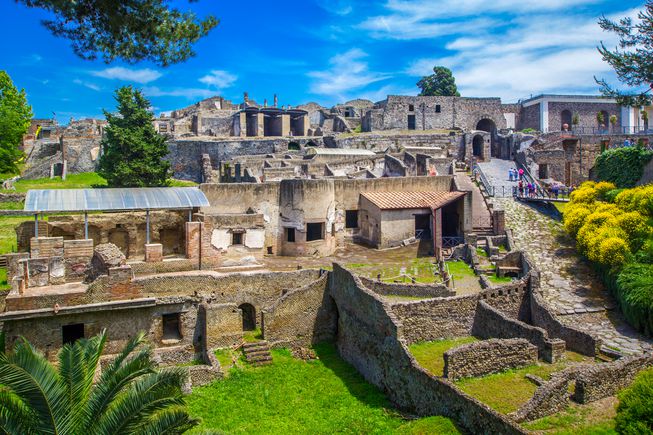考古学家在古代庞贝古城发现了回收系统
考古学家在古代庞贝古城发现了回收系统
In some ways, the ancient Roman city of Pompeii mimicked a modern city — once contained within protective city walls, as the urban area grew and prospered, it spread into the countryside, creating suburbs. But in other ways, it was extremely different.
在某种程度上,古罗马城市庞贝模仿了现代城市的样子——曾经被保护在城墙之内,随着城市的发展和繁荣,它扩展到乡村,创造了郊区。但在其他方面,情况却截然不同。

The ancient city of Pompeii was long covered in ash and debris from the eruption of Mount Vesuvius in the year 79 now serves as a valuable archeological site. (Photo: lara-sh/Shutterstock)
Archeologists say it's important to remember that all societies — past or present — don't have the same attitudes towards cleanliness or sanitation. What constitutes garbage, and how and where to keep it is decided by community members. Think about it: litter is a malleable concept, and even in the modern era it used to be acceptable to leave trash behind. Many smokers still think it's OK to toss their cigarette butts out the car window.
考古学家说,重要的是要记住,所有的社会,无论是过去还是现在,对清洁和卫生的态度都不一样。什么是垃圾,以及如何和在哪里保存垃圾是由社区成员决定的。想想看:垃圾是一个可塑的概念,即使在现代,把垃圾扔在身后也是可以接受的。许多吸烟者仍然认为把烟头扔出车窗外是可以的。Understanding how different cultures see death and garbage is one key to understanding them. In Pompeii, tombs were put in high-traffic parts of the city (to better remember the dead) and disposal pits were kept in the same spaces as water storage. They also sorted their recycling differently. Instead of packing it up and sending it to a faraway state, new evidence shows Pompeiians recycled right at home.
如何看待死亡和垃圾是理解不同文化的关键。在庞贝,坟墓被放置在城市交通繁忙的地方(为了更好地纪念死者),处理坑被放在和水储存的相同空间。他们对回收利用的分类也不同。新的证据显示,庞贝人并没有把垃圾打包送到遥远的国家,而是直接在国内回收垃圾。
Archaeologists figured this out by examining piles of detritus and the types of soil it contained. Human excrement or household food waste would leave behind organic soils in a pit, and street litter would pile against walls and get mixed in with the area's sandy soil, degrading into similar soil, not the darker, richer organic stuff. Some of that litter would be found in sizable piles, bigger than what would have been swept or blown aside by busy foot traffic.
考古学家通过研究成堆的碎石和其中包含的土壤类型得出了这个结论。人类粪便或家庭食物垃圾会在坑里留下有机土壤,街道垃圾会堆在墙边,与该地区的沙土混合,降解成类似的土壤,而不是更黑、更丰富的有机物质。有些垃圾会堆成相当大的一堆,比繁忙的人潮扫过或吹走的垃圾还要大。
As the researchers delved into 6-foot-high piles pushed against the city walls, they found materials like plaster and broken ceramic bits. Originally, these piles were thought to be part of the mess left behind when an earthquake ravaged the city 17 years before Mount Vesuvius erupted, but it's more likely to be evidence of recycling, posits Emmerson, since the archeologists found that same type of material was used as building material elsewhere in the city, and in the suburban areas.
研究人员深入研究了城墙上的6英尺高的木桩,他们发现了石膏和破碎的陶瓷碎片等材料。最初,这些木桩被认为是维苏威火山爆发前17年地震摧毁这座城市留下的残迹的一部分,但它更有可能是回收利用的证据,埃默森如此假设,因为考古学家发现同样的材料在城市的其他地方和郊区被用作建筑材料。
The archaeologists already knew that the interior walls of Pompeii's buildings would often contain pieces of broken tiles, chunks of used plaster, and pieces of household ceramics, which would be covered over with a top layer of new plaster for a finished look.
考古学家们已经知道,庞贝古城建筑的内墙通常会有破碎的瓷砖、用过的灰泥和家用陶瓷的碎片,这些碎片会被覆盖上一层新灰泥,以形成完整的外观。
Now it was obvious where that interior wall material came from — the carefully sorted "recycling bins" leaning up against the ancient city walls. It makes sense — this was a location to dump material from a tear-down or remodel, and a place where builders could then pick up material to reuse. "The piles outside the walls weren't material that's been dumped to get rid of it. They're outside the walls being collected and sorted to be resold inside the walls," Emmerson said.
现在,内墙材料的来源已经很明显了——精心分类的“回收箱”靠在古老的城墙上。这是有意义的——这是一个从拆除或改造中倾倒材料的地方,也是一个建筑商可以提取材料进行再利用的地方。“墙外的堆积物并不是用来处理垃圾的。它们在墙外被收集和分类,然后在墙内转售,”艾默森说。
In this way, the Pompeiians weren't just recycling, they were recycling locally — with building and refuse materials removed from one area of the city and used to build in another.
通过这种方式,庞贝人不仅回收利用,他们还在当地回收利用——从城市的一个地区回收建筑和垃圾材料,然后在另一个地区建造。
Considering that construction waste is at least a third — and maybe as much as 40% — of landfill space, this is a lesson modern societies could take from the ancients.
考虑到建筑垃圾至少占垃圾填埋场空间的三分之一,甚至可能高达40%,这是现代社会可以从古人身上学到的一课。
Emmerson explains why: "The countries that most effectively manage their waste have applied a version of the ancient model, prioritising commodification rather than simple removal."
埃默森解释了原因:“那些最有效管理废弃物的国家采用了一种古老的模式,优先考虑商品化,而不是简单的清除。”
- 频道推荐
- |
- 全站推荐
- 推荐下载
- 网站推荐


















